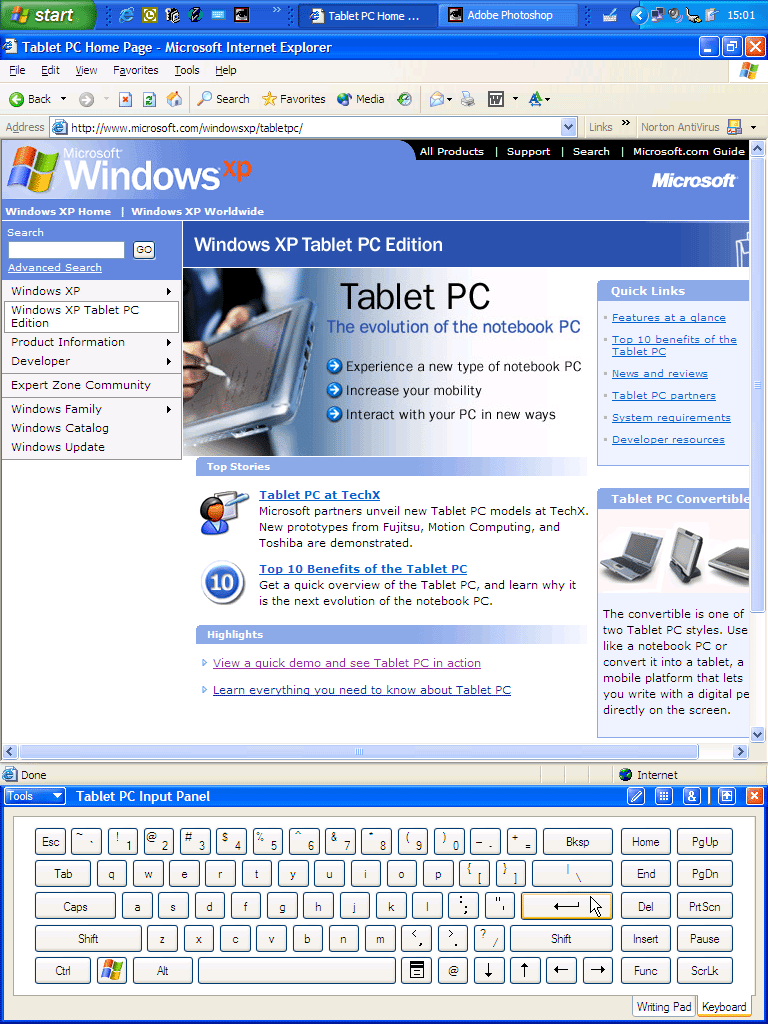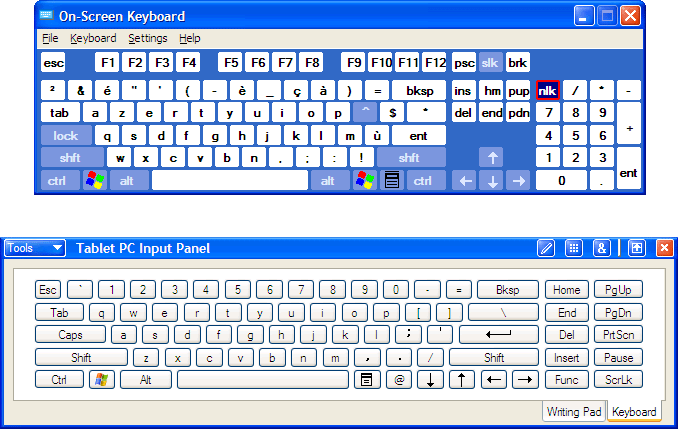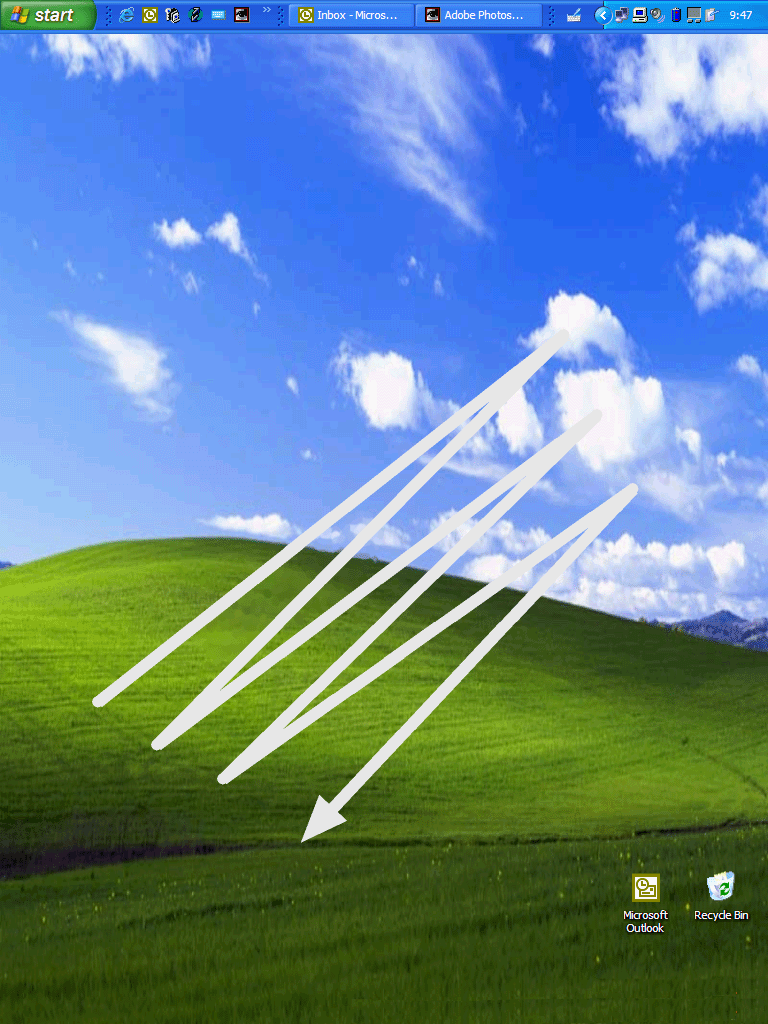Most of the time you’re using your tablet you’ll want Input Panel hidden because it takes up quite a bit of screen space. To see Input Panel, tap the Tablet PC Input Panel


Here’s an example for entering text using the Input Panel keyboard. Open Microsoft Internet Explorer, and then open Input Panel. Tap once in the Address box of Internet Explorer to select the text. Using the Input Panel keyboard, enter the URL www.microsoft.com/tabletpc/ using the Input Panel keyboard as shown in Figure 2-2. Tap the Enter key on the Input Panel keyboard when you are finished. If you’re connected to the Internet, the Tablet PC home page should appear. Incidentally, this page is a great source of information, tips, and downloads for your Tablet PC. If the page doesn’t load, try entering the full URL of http://www.microsoft.com/windowsxp/tabletpc/
Remember that using the Input Panel keyboard is just like using a standard keyboard in that you must specify where you want the text to go before you start typing. The most common mistake people make using Input Panel the first few times is forgetting to tap once on the screen to place the cursor.
If you make a mistake as you type, you can Backspace, Delete, and even use modifier keys, such as Ctrl+C for copy, just as you would with a standard keyboard. To use a modifier key, such as the Shift or Ctrl key, simply tap the modifier first and then tap the modified key. To make entering e-mail addresses a bit easier, the Input Panel keyboard has a dedicated @ key as well.
Keyboard commands, such as Ctrl+C for copy are cumbersome to enter on the Input Panel keyboard. Tap buttons or use the menus instead of the Input Panel keyboard.

The Input Panel keyboard has a few shortcomings. It lacks a number pad, and it’s fairly easy to tap the wrong key inadvertently if the keys are resized too small. If you use an alternative keyboard layout, such as a French or German keyboard, the keys on Input Panel do not appear to change even though they actually create different characters when you type them. If any of these are a problem for you, use the on-screen keyboard built into every version of Windows XP. The on-screen keyboard is found in the Accessibility folder in the Accessories folder in the Start menu. If you use this keyboard often, you can drag the icon to your Quick Launch bar or to your Start menu for easy access. Figure 2-3 shows the Windows on-screen keyboard and the Input Panel keyboard.

There are a couple of ways to make Input Panel a little more space-efficient on your screen. If you don’t mind tapping smaller keys, you can resize Input Panel. You can also enlarge Input Panel to make it easier to tap keys if you want. You might actually find it easier to type text if your keyboard is smaller because you won’t have to move your hand as far to get from one end of the keyboard to the other.
You can also undock Input Panel so that it becomes a floating toolbar. While docked, Input Panel appears at the bottom of your screen, and any open windows are resized to fit the remaining space. The undocked Input Panel floats on top of other windows, so you may drag it anywhere you want on the screen, though it might obscure some of the window you are using. While undocked, Input Panel can be resized for width as well as height and can be made quite small. To toggle Input Panel docking on and off, tap the Input Panel Tools menu and select Dock. As with pen preferences, whether to use a docked or undocked Input Panel is really a matter of personal preference. Some people like having Input Panel next to the area of the screen where they are entering text; others like having it always on the bottom. Try both and see which works best for you.
Double-tapping the Input Panel title bar will quickly dock and undock Input Panel.
Whether Input Panel is docked or not, you can hide most of it so that only the title bar appears by tapping the Hide Pen Input Area

A really cool way to make Input Panel appear is with the open Input Panel gesture. To open Input Panel this way, move your pen back and forth rapidly several times just above the screen but without actually touching it. The motion can be horizontal, vertical, or on a slant, so long as it is rapid and the pen is not in contact with the screen. The motion is also quite large by default, as shown in Figure 2-4, but can be changed in the Tablet And Pen Settings control panel on the Pen Options tab. If Input Panel was docked when it was last closed, it opens still docked. If it was undocked, it appears wherever you made the gesture. This feature is really handy because you can open and use Input Panel without moving your pen to a different part of the screen.
A gesture is any pen action designed to send a command to the computer that isn’t a mouse movement or a text entry. Right-tap is also considered a gesture.
Make the open Input Panel gesture slightly below the area where you want to enter information so that it doesn’t cover the place your text will appear.
